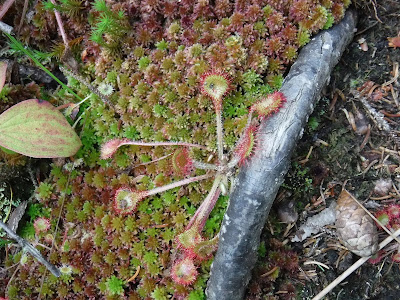To get to Long Island, we had to drive to East Ferry, about an hour's drive from our campground. There, we caught a ferry to Long Island:
We crossed the Petit Passage from East Ferry to Tiverton on Long Island and drove another 20 minutes or so to Freeport to catch a second ferry to Westport. On that second ferry ride, we caught sight of the Boar's Head Lighthouse, marking the channel known as the Grand Passage between the main body of the Bay of Fundy, on the west, and St. Mary's Bay, on the east:
To the west of our ferry crossing, we caught sight of the now unused St. Peter's Lighthouse, which marks St. Peter's Island, a major obstacle for boats plying their way into St. Mary's Bay:
Once we reached Westport on Brier Island, we drove another 10 minutes or so to reach the Grand Passage Lighthouse. We parked at the end of the road and roamed about the lighthouse grounds, admiring its position at the mouth of the Bay of Fundy:
Near the Grand Passage Lighthouse, we started a 4 mile hike on the Seal Cove Trail:
The Seal Cove Trail boasts more than seals. As we turned on the trail up the shoreline, we first ran into a small cove that other hikers had decorated with many whimsical inuksuks. Here is one example --
-- and here another:
One of our chief objectives, however, was Seal Cove itself, which is known for its small population of seals. As soon as we arrived, Kathy pulled out her spyglass to look for seals:
She was not to be disappointed! We counted NINE seals on this little rocky island, safely posititioned out in the water away from possible predators:
We marched on around the coast until we reached Gooseberry Cove. On the far side of the cove, we stopped for lunch where we could admire the Brier Island Lighthouse in the distance:
David didn't waste much time admiring the lighthouse, however, but attacked his lunchtime sandwich with vigor:
The west shore of Brier Island is known for whale sightings. As we hiked along the shoreline, we continually saw whales breaching and spouting. We also watched a whale-watching boat and a zodiac whale tour as they plied the waters off our shoreline. In the photo below, a whale breaches VERY CLOSELY to the whale-watching boat!
We finished our hike by returning to our trailhead by the Grand Passage Lighthouse, and worked our way back to the ferry, crossing to Long Island to make our way to the Balancing Rock trail. David announced the trailhead with his Leonardo Da Vinci-like pose:
The trail out to the Balancing Rock was an easy 1.5 kilometer walk along gravel paths and boardwalks:
Along the way, we were educated by various placards, including one that explained the Round-Leaved Sundew, a carnivorous plant that looks innocent enough, hanging out with some innocent mosses, but is deadly to flies, mosquitoes and other insects:
At the end of our trail, we had to descend 248 steps to the Balancing Rock. Halfway down, Kathy posed to show the drama and strong construction of the steps and boardwalk:
It wasn't long before we reached Balancing Rock itself. It is about 4 feet wide and 20 feet tall, and is a basalt column that itself balances on a wider basalt column. It is part of a formation consisting of three layers of basalt. The lowest layer consists of basalt intrusions that hardened into columns by intrusion into other rock layers as the future North America separated from the future Europe. The middle layer was made of lighter volcanic rock, which, later in history, was intruded by additional basalt columns. Over time erosion caused some of the columns to be isolated.
The geology of the Bay of Fundy is fascinating because of its location at the point where continents separated eons ago. This is the same reason that the Bay of Fundy is such a rockhound's delight, because so many types of rock formations met here, separated, got eroded by water and glaciers, smoothed and polished by rushing waters, and moved around over the millenia. We can't wait to learn more about the geology and plant life of this area as we move to the north shore of the Bay of Fundy in New Brunswick later in August.

















No comments:
Post a Comment
Note: Only a member of this blog may post a comment.